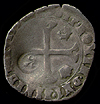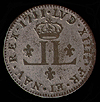French Coinage for Canada and Louisiana
I. French coins produced exclusively for Canada, Louisiana and other New World colonies
Counterstamped by the Edict of 1640
obverse |
|
reverse |
| |||
[1640] Counterstamped douzain originally from Grenoble, 1594
Obverse: HENRICVS · [IIII ·] D . G · FRAN · ET · NAV · REX ·
Reverse: [rose] SIT · NOMEN · DNI · BENEDICT · 159[4] [mintmark Z]
Weight: 31.8 g (2.06 grams) Diameter: 25.75 mm Reverse die alignment: 30°
Comments: This is a well worn hammer struck douzain from the reign of Henry IV (August 2, 1589 - May 14, 1610) originally made for use in the province of Dauphiné Part of the legend including the mintmark and part of the date are worn or clipped off. Two varieties of this coin were produced, this example represents what Jean LaFaurie and Pierre Prieur call the type two variety (number 1096 in their Monnaies des rois de France, vol. 2, 1956, p. 150). There is also a type two variant without the the king's name in the legend. The variety displayed here was minted in the capitol of Dauphiné, that is Grenoble, 1593-1597. The obverse displays the provincial shield which is crowned and quartered with the a grouping of three fleur-de-lys in the upper left and lower right quadrants and dolphins in the other two quadrants (the dolphin, dauphin in French, is the symbol of the Dauphiné ). On either side of the shield is H for King Henry IV. The upper right portion of the planchet bows outward due to the force of the counterstamp that was added to the reverse. On the reverse is a cross with a crown in the upper left and lower right quadrants and a dolphin in the other two quadrants. The counterstamp was added pursuant to the edict of 1640 validating the coin for circulation in Nouvelle France. This coin was impressed on the reverse with a punch displaying a fleur-de-lys with an oval beaded border. The counterstamp was forcefully struck causing the planchet to bow such that the coin will not lay flat. The stamp caused the surrounding metal to extrude about 1/16th of an inch. The scan shows the depth and bowing of the surrounding area.
Provenance: Purchased through the Robert H. Gore, Jr. Numismatic Endowment at the Fourth annual C4 Convention Auction of Chris McCawley and Bob Grellman (M & G Auctions) on November 21, 1998, lot 18.
obverse |
|
reverse |
| |||
[1640] Counterstamped douzain originally from Avignon, dating to Clement VIII (1592-1608)
Obverse:
Reverse: [click here for 1200 dpi image of the counterstamp detail]
Weight: 30.2 g (1.96 grams) Diameter: 24.41 mm
Comments: This is a well worn hammer struck Carlino from Avignon dating to Clement VIII (1592-1608). The obverse contains the papal shield with two crossed keys with the letter A to either side. The reverse consists of a cross, quartered with crosses in the upper left and lower right and lions in the other two quarters. A example of this coin type, showing the counterstamp on the obverse, can be found in Breen's, "North American Colonial Coinages under the French Regime (1640-1763)," in Studies on Money in Early America, ed. by Eric Newman and Richard Doty, New York: American Numismatic Society, 1976, on p. 46. According to Breen the counterstamp of 4mm by 2mm usually contains an oval border of 28 beads, although some variations exist. Neither of out two examples show a full strike.
Provenance: Purchased through the Robert H. Gore, Jr. Numismatic Endowment at the Fourth annual C4 Convention Auction of Chris McCawley and Bob Grellman (M & G Auctions) on November 21, 1998, lot 16.
30 Deniers or double sols from Lyon 1710-1713
obverse |
|
reverse |
| |||
1711-D Breen 284 Lyon French Colonies - 30 deniers
Obverse: LVD · XIIII · FR · ET · NAV · REX · 1711 ·
Reverse: PIECE · DE · XXX · DENIERS · D ·
Weight: 34.8 g (2.25 grams) Diameter: 28.93 mm Reverse die alignment: 180°
Comments: These coins were made of billon, composed of 20% silver and 80% copper, with a silver wash. The obverse legend translates as "Louis XIV, King of France and Navarre." On the Lyon coins there was no mintmaster or engraver marks. On varieties from other mints the final stop on the obverse is replaced by a mintmaster mark, while on the reverse the stop following the roman numeral, XXX · DENIERS, is replaced by an engraver's mark. These coins were sometimes called Mousquetaires as the Greek cross on the reverse resembled the cross worn by the musketeers. Below the cross is the mintmark D for Lyon.
Provenance: Purchased through the Robert H. Gore, Jr. Numismatic Endowment at the Fourth annual C4 Convention Auction of Chris McCawley and Bob Grellman (M & G Auctions) on November 21, 1998, lot 25.
| British Silver | Section Contents | French coinage p. 2 |
|
For viewing tips and information on optimal computer settings click
here.
For questions or comments contact Special Collections by: |





